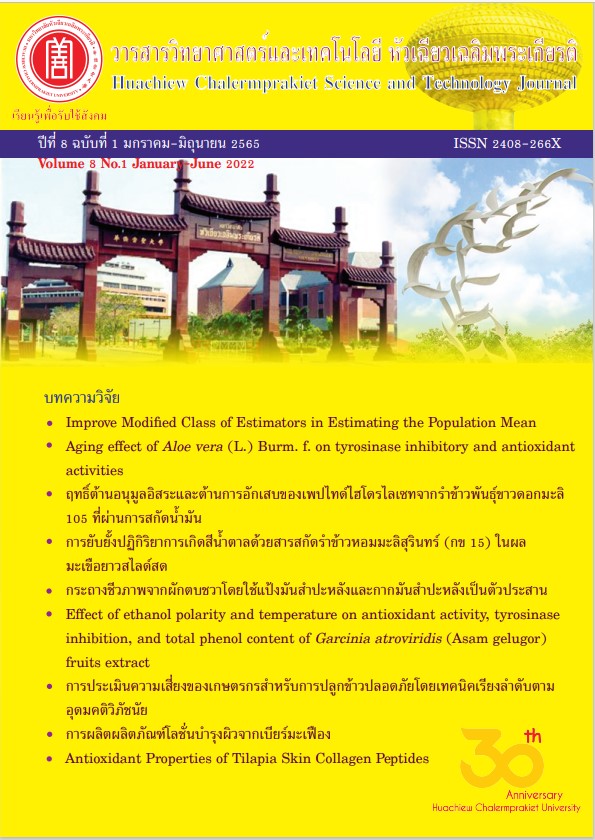ฤทธิ์ต้านอนุมูลอิสระและต้านการอักเสบของเพปไทด์ไฮโดรไลเซท จากรำข้าวพันธุ์ขาวดอกมะลิ 105 ที่ผ่านการสกัดน้ำมัน
คำสำคัญ:
รำข้าว, เพปไทด์ไฮโดรไลเซท , ฤทธิ์ต้านอนุมูลอิสระ , ฤทธิ์ต้านการอักเสบบทคัดย่อ
งานวิจัยนี้มีวัตถุประสงค์เพื่อศึกษาฤทธิ์ในการต้านอนุมูลอิสระและต้านการอักเสบของเพปไทด์ไฮโดรไลเซทจากรำข้าวพันธุ์ขาวดอกมะลิ 105 ซึ่งเป็นวัสดุเศษเหลือที่ได้จากอุตสาหกรรมน้ำมันรำข้าว เพปไทด์ไฮโดรไลเซทจากรำข้าวเตรียมด้วยกระบวนการย่อยกากรำข้าวโดยใช้เอนไซม์อัลคาเลสปริมาณร้อยละ 0.875 เอนไซม์ต่อรำข้าวแห้ง เพปไทด์ไฮโดรไลเซทที่ผลิตได้นำมาศึกษาชนิดและปริมาณกรดอะมิโน (amino acids profile) ความสามารถในการต้านอนุมูลอิสระ (antioxidant activity) และความสามารถในการต้านการอักเสบ (anti-inflammatory activity) ผลการทดลองพบว่า เพปไทด์ไฮโดรไลเซทที่ผลิตได้ประกอบด้วยกรดอะมิโนที่อยู่ในรูปเพปไทด์สายสั้น (short polypeptide) ร้อยละ 27.66 มีความสามารถต้านอนุมูลอิสระ (DPPH) (IC50 = 1.15 mg/mL) และสามารถรีดิวส์เฟอร์ริก (FRAP) 157.12 ไมโครโมล Fe2+ ต่อกรัม นอกจากนี้เพปไทด์ไฮโดรไลเซทจากรำข้าวพันธุ์ขาวดอกมะลิ 105 ที่ความเข้มข้น 50 ไมโครกรัมต่อมิลลิลิตร สามารถต้านการอักเสบด้วยการยับยั้งการผลิตสารก่ออักเสบชนิด Tumor necrosis factor- (TNF-
), Interleukin-6 (IL-6), Interleukin-1
(IL-1
) และ Nitric oxide (NO) ได้ร้อยละ 49.07, 34.66, 44.98 และ 41.13 ตามลำดับของเซลล์แมคโครฟาจ RAW 264.7 ที่ถูกกระตุ้นให้อักเสบด้วย Lipopolysaccharide (LPS) เพียงอย่างเดียว ผลการศึกษานี้แสดงให้เห็นว่าเพปไทด์ไฮโดรไลเซทจากรำข้าวพันธุ์ขาวดอกมะลิ 105 มีประสิทธิภาพในการต้านอนุมูลอิสระและต้านการอักเสบ และสามารถนำมาประยุกต์ใช้เป็นส่วนประกอบในอาหารฟังก์ชัน (functional food) หรืออาจนำไปใช้ประโยชน์ทางการแพทย์ได้ในอนาคต
เอกสารอ้างอิง
Biswas S, Das R, Banerjee ER. Role of free radicals in human inflammatory diseases: review. AIMS Biophys 2017;4(4):596-614.
Saisavoey T, Sangtanoo P, Reamtong O, Karnchanatat A. Antioxidant and anti-inflammatory effects of defatted rice bran (Oryza sativa L.) protein hydrolysates on RAW 264.7 macrophage cells. J Food Biochem 2016;40(6):731-40.
Heo SY, Ko SC, Jung WK. The pepsinolytic hydrolysate from Johnius belengerii frame inhibited LPS-stimulated production of pro-inflammatory mediators via the inactivating of JNK and NF-kB pathways in RAW 264.7 macrophages. Fish Aquatic Sci 2018;21(14):1-8.
Amagliani L, O'Regan J, Kelly AL, O'Mahony JA. The composition, extraction, functionality and applications of rice proteins: A review. Trends Food Sci Technol 2017;64:1–12.
Chaijaroen T. Functional and biological properties of enzymatic hydrolysate from defatted rice bran by using partial purified Nile Tilapia (Oreochromis niloticus) Viscera extract. Ph.D. Thesis, Prince of Songkla University. Songkla; 2015.
Phantuwong N, Thongraung C, Yupanqui CT. Enzymatic hydrolysis on protein and -glucan content of Sang-yod rice bran hydrolysates and their anti-inflammatory activity on RAW 264.7 cells. Funct Foods Health Dis 2017;7(12):958-71.
Chanput W, Lawyer R. The potential of fractionated rice bran protein hydrolysates as antioxidative and anti-inflammatory agents. J Nutr Sci Vitaminol 2020;66:349–55.
Chen G, Zhao L, Zhao L, Cong T, Bao S. In Vitro Study on Antioxidant activities of peanut protein hydrolysate. J Sci Food Agric 2007;87:357–62.
Thamnarathip P, Jangchud K, Nitisinprasert S, Vardhanabhuti B. Identification of peptide molecular weight from rice bran protein hydrolysate with high antioxidant activity. J Cereal Sci 2016;69:329-35.
พัสตราภรณ์ ทองอิ่มพงษ์, ณัฎฐา เลาหกุลจิตต์, อรพิน เกิดชูชื่น, สุรพงษ์ พินิจกลาง, เบญจวรรณ ธรรมธนารักษ์. สมบัติต้านอนุมูลอิสระและสมบัติเชิงหน้าที่ของโปรตีนจากกากทานตะวันที่ไฮโดรไลซ์ด้วยเอนไซม์โบรมิเลนและ Flavourzyme®. วารสารวิจัยและพัฒนา มจธ. 2559;39(4):565–83.
Sonklin C, Laohakunjit N, Kerdchoechuen O. Assessment of antioxidant properties of membrane ultrafiltration peptides from mungbean meal protein hydrolysates. PeerJ 2018;6(e5337):1–20.
Chen HJ, Dai FJ, Chen CY, Fan SL, Zheng JH, Huang YC, et al. Evaluating the antioxidants, whitening and antiaging properties of rice protein hydrolysates. Molecules 2021;26(12):3605.
Hernandez-Ledesma B, Miralles B, Amigo L, Ramos M, Recio I. Identification of antioxidant and ACE-inhibitory peptides in fermented milk. J Sci Food Agric 2005;85(6):1041–8.
Mendis E, Rajapakse N, Kim SK. Antioxidant properties of a radical-scavenging peptide purified from enzymatically prepared fish skin gelatin hydrolysate. J Agric Food Chem 2005;53(3):581–7.
Inkanuwat A, Sukaboon R, Reamtong O, Asawanonda P, Pattaratanakun A, Saisavoey T, Sangtanoo P, Karnchanatat A. Nitric oxide synthesis inhibition and anti-inflammatory effect of polypeptide isolated from chicken feather meal in lipopolysaccharide-stimulated RAW 264.7 macrophages. Food Technol Biotechnol 2019;57(2):200-12.
Jangmesin K, Rimkeeree H, Tadakittisarn S. Enzymatic optimization of riceberry bran protein hydrolysate extraction and characterization. Curr Appl Sci Technol 2017;17(2):200–23.
Lim EWT, Leach ST, Lemberg DA, Day AS. A Brief overview of nutrient anti-inflammatory molecules and their in vitro and in vivo activity. J Nutri Med Diet Care 2016;2(2):1-7.
He F, Wu C, Li P, Li N, Zhang D, Zhu Q, Ren W, Peng Y. Functions and signaling pathways of amino acids in intestinal inflammation. BioMed Res Int 2018;9171905:1-13.
Montserrat-de la Paz S, Villanueva A, Pedroche J, Millan F, Martin ME, Millan-Linares MC. Antioxidant and anti-Inflammatory properties of bioavailable protein hydrolysates from lupin-derived agri-waste. Biomolecules 2021;11(10):1458.
ดาวน์โหลด
เผยแพร่แล้ว
รูปแบบการอ้างอิง
ฉบับ
ประเภทบทความ
สัญญาอนุญาต
ลิขสิทธิ์ (c) 2022 วารสารวิทยาศาสตร์และเทคโนโลยี หัวเฉียวเฉลิมพระเกียรติ

อนุญาตภายใต้เงื่อนไข Creative Commons Attribution-NonCommercial-NoDerivatives 4.0 International License.
บทความทุกบทความที่ได้รับการตีพิมพ์ถือเป็นลิขสิทธิ์ของ คณะวิทยาศาสตร์และเทคโนโลยี มหาวิทยาลัยหัวเฉียวเฉลิมพระเกียรติ



